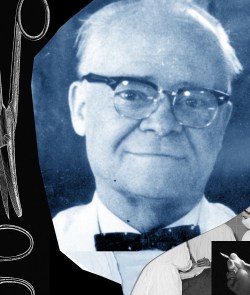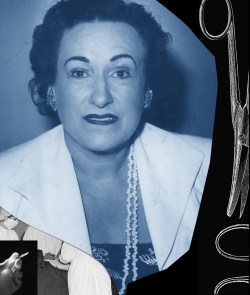This article is the third of a four-part series based on the upcoming book by Marvin Olasky and Leah Savas, The Story of Abortion in America: A Street-Level History, 1652–2022.
British theologian and missionary Lesslie Newbigin said the church is a Christian’s “home base for a mission to the ends of the earth.” Is that true in spirit as well as in geography? Who is at the other end of the earth from a Christian pregnancy resource center, even though it’s located next door? And who might be under tremendous pressure in a post-Roe era?
Could it be an abortionist? Thirty years ago, I spent some time with Dr. Bernard Nathanson, who had professed faith in Christ after presiding over the biggest abortion business in New York City in 1971 and 1972. When he studied ultrasound video in 1974, though, Nathanson realized he had killed human beings. As pro-life advocates talked with him, Nathanson found comfort in “the special role for forgiveness” within Christianity.
I’ve read lots of books about and by abortionists and learned that each had a different rationale. Let’s start with Robert Spencer, who aborted at least 40,000 babies from the 1920s through the 1960s. Laudatory biographer Vincent Genovese wrote that Spencer “without any sense of loss” would “gently” place into a basin the tiny children he had just aborted.
Spencer felt no grief because as a student at Penn State he had become a confirmed Darwinist. “Zoologists look upon an embryo as a parasite. … Murder is the basis for life, for one form of life eats another,” he later wrote. “I am an evolutionist, hence I am an atheist. … The basic structure of all matter is electrical.”
 Illustration by Mallory Rentsch / Source Images: WikiMedia Commons
Illustration by Mallory Rentsch / Source Images: WikiMedia CommonsSpencer lived in Ashland, Pennsylvania, which had a population of 5,000 in 1960 and has about half that now. His practice wasn’t a secret. Some residents who protected him benefited economically from Spencer’s work, since the thousands of abortion seekers who came to Ashland from across the US patronized local hotels and other businesses.
It appears that Spencer killed only one of the women he gave an abortion during his 40-year career. A jury that included at least one former Spencer patient found him not guilty.
A second abortionist, Ruth Barnett, displayed a different motivation. Although she was not a doctor, she was as competent in abortion as the best. A close friend of Planned Parenthood founder Margaret Sanger, Barnett performed about 40,000 illegal abortions from 1918 to 1968 in Portland, Oregon, with at least two-thirds of the women coming to her by referral from established doctors.
Barnett’s self-appraisal seems accurate:
I have never lost a single patient. … I have a light touch. … In the movies, they always depict the fallen women sneaking up a dirty, rickety stairway to a dismal room—or making her way, furtively, into a dark alley that leads to a decrepit shack where some alcoholic doctor or untutored butcher performs the operation. … A clinic such as mine was not that way at all.
Her biographer, Rickie Solinger, describes Barnett as “clean and careful and very highly skilled” and says her operating rooms “were spotlessly antiseptic.”
Barnett’s memoir and biography suggest she became an abortionist partly out of revenge. An early sexual experience with “Frank” left her pregnant:
He was not to blame, he said. What kind of a little fool had I been to be so careless?… “You got yourself that way, now get yourself out of it.” Seeing the look of amazement on my face, he added a thrust that I’ve heard second-hand a thousand times since. “How do I know I’m responsible anyways? You’ve been going around with other guys.”
Years later Barnett recalled, “He turned and hurried away. I never saw him again. In the years that followed, I have observed many ‘Franks.’ … For years I hated Frank. So it was no surprise to me to find many of my patients had the same implacable hatred for the man responsible.”
Barnett raged not only against men who exploited her but the women snubbing her daughter, Maggie, who entered the University of Oregon in 1932 and tried to pledge a sorority, Alpha Chi Omega. Members rejected her because of her mom’s occupation: Barnett was “screaming and crying in rage” but then told her daughter, “For every sorority girl that comes in my office, you’ll get a new dress!”
Maggie recalled, “I was the most fashionable and best outfitted girl at the university that season. And also the wildest, wickedest, drunkenest, most daring, and most promiscuous.” Barnett aborted six of Maggie’s children—her own grandchildren.
 Illustration by Mallory Rentsch / Source Images: WikiMedia Commons
Illustration by Mallory Rentsch / Source Images: WikiMedia CommonsBarnett also liked earning at least $9 million (more than $100 million today) and buying “jewelry, expensive bric-a-brac, minks.” Maggie recalled her mom telling her, “Buy yourself a man, a husband, a lover. What can’t money buy? … We had about four or five fur coats apiece. … She loved jewelry. She had some gorgeous pieces.”
A third abortionist, Edgar Keemer Jr. (1913–1980), combined resentment and ideology. He grew up in a middle-class Black home hoping to echo his father, who rose from a poor rural background to become a pharmacology professor. Keemer Jr. tried to develop a well-paid practice in Indiana, but the local medical society denied him membership on racial grounds and the local hospital refused him admitting privileges.
Keemer visited New York City and Chicago but found underpaid Black doctors there moonlighting as railway porters. He settled in Detroit, where Blacks had entered the auto industry at good wages and Wayne County’s welfare system paid for doctors’ visits. Keemer let other Black physicians know that he would do abortions. His initial patients were their relatives. As others became aware of his clean clinical setting and maternal safety record, referrals increased.
When the United States entered World War II, Keemer tried to enlist in the navy as a doctor but encountered racial slurs and suggestions that he work in the kitchen or mop floors. The NAACP, trying to show patriotism, pressured him.
Keemer later said only one person “came not to lecture me. … He was a member of the Socialist Workers Party,” the Communist offshoot that supported Leon Trotsky in his battle against Joseph Stalin. Keemer joined the SWP in 1943, committed to replacing “capitalism with socialism wherein every man and every woman would be guaranteed a satisfying function in society”––if they survived.
In his autobiography, Keemer said he performed 30,000 abortions. When we add his work to Spencer’s and Barnett’s, we find that these three mass murderers apparently wiped out at least 110,000 unborn children. It can be tempting to demonize them, but they too, like Bernard Nathanson who presided over 60,000 abortions, were created in God’s image.
Once Nathanson realized the enormity of his sin, he “would awaken each morning at four or five o’clock, staring into the darkness and hoping (but not praying yet) for a message to flare forth acquitting me before some invisible jury.” Eventually, “for the first time in my entire adult life, I began to entertain seriously the notion of God … who problematically had led me through the proverbial circles of hell, only to show me the way to redemption and mercy through His grace.”
For Nathanson to change, he had to come to two understandings: that the life in a woman’s womb is human and worthy of protection and that God’s grace is boundless, able to reach even someone with the blood of thousands on his hands. Those are truths that the church, too, can carry into a post-Roe world.
Content adapted from The Story of Abortion in America by Marvin Olasky and Leah Savas, ©2023. Used by permission of Crossway, a publishing ministry of Good News Publishers.













